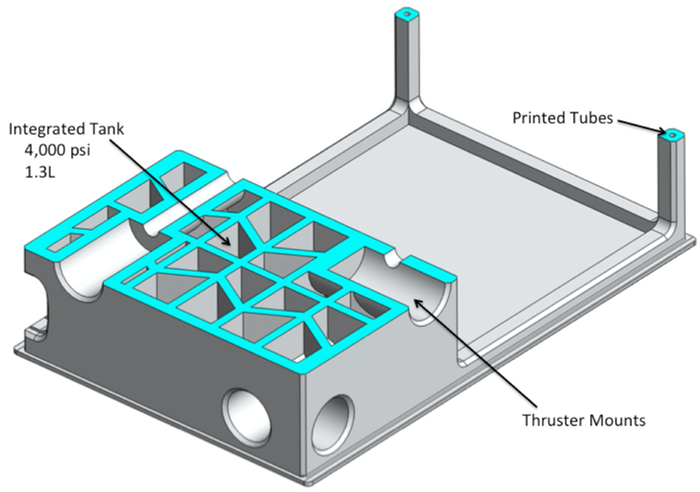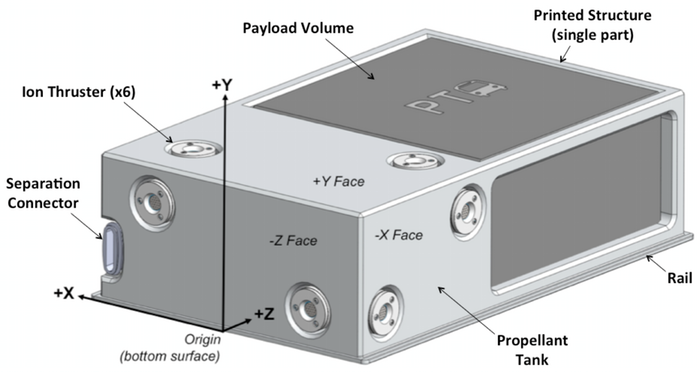PrintTheBus Is Taking On the NASA CubeQuest Challenge with 3D Printed Satellite
Oh yeah, 3D printing really is rocket science.
At least it is if you’re Nick Lamarre, a member of PrintTheBus, a group of space enthusiasts who are set on 3D printing a small satellite built to compete in NASA’s $5 Million CubeQuest Challenge and make it all the way to the moon.
“We’re printing a one-piece aluminum satellite structure with empty spaces to store propellant. The empty spaces come from any extra volume in our satellite — so we’re making a propellant tank from all the unused space,” PrintTheBus describes on the Kickstarter page to crowdfund the exploit. “We’re also developing things like valves, battery mounts, and isolators we can print-in to save space. No threads, interfaces, tubes, brackets…everything is integrated into one single piece.”
A “satellite bus” is the vehicle that moves a payload where it needs to go in space, and the goal of PrintTheBus is to create “the most capable satellite structure while leaving open the largest volume possible for the payload.”
 The 3D printed structure alone will cost $15,500 to build, and another $6,500 will be needed to “stress relieve” the structure, grind and anodize rails, and apply a chemical conversion coat. The price for vibration testing the satellite at a rental facility with an electrodynamic shaker will take a cool $12,000 and that thermal vacuum testing will set the project back another $10,000. These costs, plus Kickstarter and payment fees, ultimately add up to $49,005; the team are hoping to raise $49,000 through their crowdfunding campaign.
The 3D printed structure alone will cost $15,500 to build, and another $6,500 will be needed to “stress relieve” the structure, grind and anodize rails, and apply a chemical conversion coat. The price for vibration testing the satellite at a rental facility with an electrodynamic shaker will take a cool $12,000 and that thermal vacuum testing will set the project back another $10,000. These costs, plus Kickstarter and payment fees, ultimately add up to $49,005; the team are hoping to raise $49,000 through their crowdfunding campaign.
And the team involved aren’t exactly hobbyists. Lamarre and his partners, Alex and Ernie, are a professional engineering team with a mighty serious pedigree.
Lamarre has worked for Planetary Systems Corp and Busek Space Propulsion. Alex is a mechanical engineer, Solidworks “guru,” and manufacturing expert with a detail-oriented project management style, and Ernie is a computer scientist, computer and systems engineer, and “all-around genius.”
The reason a small satellite has never been to the moon is that, in the past, there’s been a lack of space to fit all the necessary systems needed to complete the journey.
“Because we’re printing our satellite bus, we can do it with far less components — no fasteners, brackets, etc. — to fit everything we need. That’s giving us the advantage,” Lamarre says. “We need to deliver the best satellite possible for the NASA Cube Quest Challenge, and that means we need you checking our work. You’ll get the models to print your own satellite, or use the technology for your next project.”
The NASA Cube Quest Challenge is a competition to design, build, and test a small satellite that goes to the moon, and to win it, entrants will compete in three events.
The “Ground Tournaments” are design competitions meant to rank the probability of a project’s success and mission safety. The “Deep Space Derby” will be an in-space competition offering awards for the best data burst rate, largest aggregate data over time, spacecraft longevity, and farthest communication from Earth. And the “Lunar Derby,” another in-space competition, will offer awards for achieving lunar orbit, best burst data rate, largest aggregate data over time, and spacecraft longevity to complete the challenge. Awards, totaling $5 million overall, are broken down to $3 million for the Deep Space Derby, $1.5 million for the Lunar Derby, and $500K for Ground Tournaments.
The PrintTheBus project hopes to take home the prizes for entering lunar orbit and spacecraft longevity.
To make it happen, the satellite will hitch a ride aboard a larger spacecraft headed to geostationary orbit. Once it’s made it that far, the device will need to generate a velocity of 1,600 meters per second on its own to reach lunar orbit using an onboard xenon propellant system from a tank capable of holding 4,000 psi and delivering an operational pressure of 1,000 psi.
PrintTheBus will be printed will be built using direct metal laser sintering (DMLS) to producing what’s called a “100% dense” part using powders developed for the application like aluminum, stainless steel, Inconel alloy or titanium.
And, should you be a well-heeled space cadet and rocket science enthusiast, a pledge to the PrintTheBus Kickstarter campaign of $10,000 means you can have your payload or experiment ride along through the vibration testing process. Less expensive options are available as well. The Kickstarter campaign runs through April 17.
What do you think of the PrintTheBus project to 3D print the first satellite capable of reaching the moon? Let us know in the PrintTheBus forum thread on 3DPB.com. Check out the video below for more information from PrintTheBus.
Subscribe to Our Email Newsletter
Stay up-to-date on all the latest news from the 3D printing industry and receive information and offers from third party vendors.
Print Services
You May Also Like
New Business: Temporary, Migratory, & Modular 3D Printed Architecture
If we look at potentially emerging 3D printing businesses, then architecture has not been fully explored. Yes, there is a lot of house 3D printing going on worldwide. From deployable...
3D Printing News Briefs, April 19, 2025: Material Extrusion Standard, Metal Powder, & More
In today’s 3D Printing News Briefs, we’re covering a proposed standard for material extrusion, before moving on to business and metal powder. We’ll end with a commercial store’s robotic 3D...
Japan Unveils World’s First 3D Printed Train Station
Japan is now home to what we believe is the world’s first train station built with 3D printing technology. Located in Arida City, just south of Osaka, the new Hatsushima...
restor3d Raises $38M to Expand 3D Printed Orthopedic Implants
Backed by $38 million in new funding, restor3d is pushing ahead with the launch of four personalized implant lines, set to roll out in 2025 and 2026. This latest venture...

























